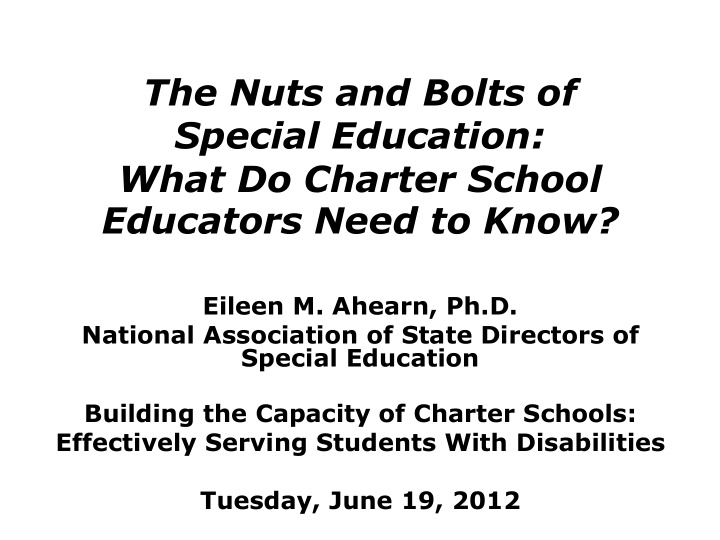



The Nuts and Bolts of Special Education: What Do Charter School Educators Need to Know? Eileen M. Ahearn, Ph.D. National Association of State Directors of Special Education Building the Capacity of Charter Schools: Effectively Serving Students With Disabilities Tuesday, June 19, 2012
Topics to be Covered • How special education fits into a charter school. • A brief history of special education. • A review of some requirements of special education. • Some topics of concern. • Discussion and Q & A. 6/19/2012 Ahearn Presentation 2
The Big Picture Structure of the American education system: • SEA • LEA (and sometimes IDs) • Schools How do charter schools fit into the public education system? • It depends on many factors, e.g. state law, authorizer, type of charter • Retrofitting is what happens ! 6/19/2012 Ahearn Presentation 3
Legal Identity of a Charter School For Special Education Purposes Legal Status: A charter school is either its own LEA or part of another LEA for special education purposes . Linkage: The continuum of linkage, reflected in state law, policy, charter applications and charter agreements, spells out how legal identity is enacted . LEA status and linkage shape the design and implementation of special education in a charter school. 6/19/2012 Ahearn Presentation 4
Critical Implications of LEA Status For LEA charter schools: • The charter school has full responsibility for implementing IDEA and state special education laws and regulations. The charter school may hire its own staff or contract with another LEA or an organization for special education services. The charter school will be monitored by the SEA in the same manner as any other LEA. For charter schools that are part of an LEA: • Arrangements for service delivery in the charter school vary widely, but responsibility remains with the district. The charter school needs to negotiate a detailed special education operations contract with the LEA. Maintaining positive working relationships with LEA special education staff is critical. 6/19/2012 Ahearn Presentation 5
A Mini-History of Special Education • Before the 1970‟s : Exclusion of students with disabilities 1965 – ESEA Bureau for Education of the Handicapped (now OSEP) Eventual change to using “people - first language” Extensive litigation • 1970‟s : 1973 – Section 504 of the Rehabilitation Act 1974 – Family Educational Rights and Privacy (FERPA) 6/19/2012 Ahearn Presentation 6
Mini- History (cont’d) 1975 – The Education for All Handicapped Children Act known as P. L. (Public Law) 94-142 ─ since renamed the Individuals with Disabilities Education Act (IDEA) • 1990‟s and Beyond : 1990 - Americans with Disabilities Act (ADA) that adopted education requirements from Section 504 2001 Reauthorization of ESEA as No Child Left Behind (NCLB) 6/19/2012 Ahearn Presentation 7
Mini- History (cont’d ) • Historical overview: Importance of the extensive litigation in special education based on the many laws that apply to the education of students with disabilities ─ special education has earned the descriptor of “litigious.” Extensive details contained in each of the laws and their related regulations. The adoption in each state of at least one special education law implementing the IDEA. 6/19/2012 Ahearn Presentation 8
Special Education Requirements • Basic Steps in the IEP Process: Referral of a child for an evaluation to determine eligibility for special education (verbal or in writing). Evaluation in all areas of suspected disability after parental consent is obtained. Determination of the child as a “child with a disability” as defined in IDEA. IEP written within 30 calendar days including specially designed instruction and related services to be provided. 6/19/2012 Ahearn Presentation 9
Requirements (cont’d) IEP implemented after parental approval. Progress measured on goals as stated in the IEP and parents informed of progress toward achievement of the child‟s annual goals. IEP Reviewed at least once a year or more often if parents or the school ask for a review. IEP reevaluated at least once every 3 years unless parents and the school agree it is not necessary. Parental consent is required for a reevaluation . 6/19/2012 Ahearn Presentation 10
Important Special Education Concepts • FAPE – free appropriate public education • LRE – least restrictive environment • Definition of „special education‟ • Definition of „child with a disability‟ • Definition of related services • Disproportionality/Overrepresentation • Independent Evaluation • Procedural Safeguards • Due Process Hearing • Transition services 6/19/2012 Ahearn Presentation 11
IDEA Disability Categories • Autism • Deaf-blindness • Deafness • Developmental delay • Emotional disturbance • Hearing impairment • Intellectual disability (cont‟d) 6/19/2012 Ahearn Presentation 12
Disability Categories (cont’d) • Multiple disabilities • Orthopedic impairment • Other health impairment • Specific learning disability • Speech or language impairment • Traumatic brain injury • Visual impairment, including blindness 6/19/2012 Ahearn Presentation 13
Critical Issues • Enrollment of students with disabilities in charter schools: pending litigation in New Orleans and DC • Charter schools designed for students with disabilities • Parental rights and the Procedural Safeguards Notice • Assessment of students with disabilities 6/19/2012 Ahearn Presentation 14
Additional Information • Handouts in the binder for this session are: – Questions and Answers about IDEA: Purposes and Key Definitions – The Basic Special Education Process – Special Education in Charter Schools: Nuances in Implementation – References and Resources on Special Education in Charter School • Availability of recorded materials for other sessions 6/19/2012 Ahearn Presentation 15
Discussion/Q&A My contact information is: Eileen Ahearn, Project Director Nat’l Assn of State Directors of Special Education 225 Reinekers Lane, Suite 420 Alexandria, VA 22314 Phone: 703-519-1497 Email: eileen.ahearn@nasdse.org 6/19/2012 Ahearn Presentation 16
Recommend
More recommend